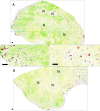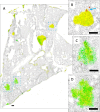Accumulation of liposomes in metastatic tumor sites is not necessary for anti-cancer drug efficacy
- PMID: 38961395
- PMCID: PMC11223361
- DOI: 10.1186/s12967-024-05428-9
Accumulation of liposomes in metastatic tumor sites is not necessary for anti-cancer drug efficacy
Abstract
Background: The tumor microenvironment is profoundly heterogeneous particularly when comparing sites of metastases. Establishing the extent of this heterogeneity may provide guidance on how best to design lipid-based drug delivery systems to treat metastatic disease. Building on our previous research, the current study employs a murine model of metastatic cancer to explore the distribution of ~ 100 nm liposomes.
Methods: Female NCr nude mice were inoculated with a fluorescently labeled, Her2/neu-positive, trastuzumab-resistant breast cancer cell line, JIMT-1mkate, either in the mammary fat pad to create an orthotopic tumor (OT), or via intracardiac injection (IC) to establish tumors throughout the body. Animals were dosed with fluorescent and radio-labeled liposomes. In vivo and ex vivo fluorescent imaging was used to track liposome distribution over a period of 48 h. Liposome distribution in orthotopic tumors was compared to sites of tumor growth that arose following IC injection.
Results: A significant amount of inter-vessel heterogeneity for DiR distribution was observed, with most tumor blood vessels showing little to no presence of the DiR-labelled liposomes. Further, there was limited extravascular distribution of DiR liposomes in the perivascular regions around DiR-positive vessels. While all OT tumors contained at least some DiR-positive vessels, many metastases had very little or none. Despite the apparent limited distribution of liposomes within metastases, two liposomal drug formulations, Irinophore C and Doxil, showed similar efficacy for both the OT and IC JIMT-1mkate models.
Conclusion: These findings suggest that liposomal formulations achieve therapeutic benefits through mechanisms that extend beyond the enhanced permeability and retention effect.
Keywords: Enhanced permeability and retention effect; Inter- and intra-tumor heterogeneity; Liposomes; Metastases/metastasis; Pre-clinical models; Translational research; Tumor microenvironment.
© 2024. The Author(s).
Conflict of interest statement
The authors declare no competing interests.
Figures










Similar articles
-
Inter-Metastatic Heterogeneity of Tumor Marker Expression and Microenvironment Architecture in a Preclinical Cancer Model.Int J Mol Sci. 2021 Jun 13;22(12):6336. doi: 10.3390/ijms22126336. Int J Mol Sci. 2021. PMID: 34199298 Free PMC article.
-
Prolonged retention of liposomes in the pleural cavity of normal mice and high tumor distribution in mice with malignant pleural effusion, after intrapleural injection.Int J Nanomedicine. 2019 May 23;14:3773-3784. doi: 10.2147/IJN.S202568. eCollection 2019. Int J Nanomedicine. 2019. PMID: 31213801 Free PMC article.
-
High-resolution 3D visualization of nanomedicine distribution in tumors.Theranostics. 2020 Jan 1;10(2):880-897. doi: 10.7150/thno.37178. eCollection 2020. Theranostics. 2020. PMID: 31903157 Free PMC article.
-
Future directions of liposome- and immunoliposome-based cancer therapeutics.Semin Oncol. 2004 Dec;31(6 Suppl 13):196-205. doi: 10.1053/j.seminoncol.2004.08.009. Semin Oncol. 2004. PMID: 15717745 Review.
-
Towards clinical translation of ligand-functionalized liposomes in targeted cancer therapy: Challenges and opportunities.J Control Release. 2018 May 10;277:1-13. doi: 10.1016/j.jconrel.2018.02.040. Epub 2018 Mar 1. J Control Release. 2018. PMID: 29501721 Review.
References
-
- Gordon AN, Tonda M, Sun S, Rackoff W, Doxil Study 30-49 Investigators Long-term survival advantage for women treated with pegylated liposomal doxorubicin compared with topotecan in a phase 3 randomized study of recurrent and refractory epithelial ovarian cancer. Gynecol Oncol. 2004;95:1–8. doi: 10.1016/j.ygyno.2004.07.011. - DOI - PubMed
-
- O’Brien MER, Wigler N, Inbar M, Rosso R, Grischke E, Santoro A, et al. Reduced cardiotoxicity and comparable efficacy in a phase III trial of pegylated liposomal doxorubicin HCl (CAELYX/Doxil) versus conventional doxorubicin for first-line treatment of metastatic breast cancer. Ann Oncol. 2004;15:440–449. doi: 10.1093/annonc/mdh097. - DOI - PubMed
MeSH terms
Substances
Grants and funding
LinkOut - more resources
Full Text Sources
Research Materials
Miscellaneous

